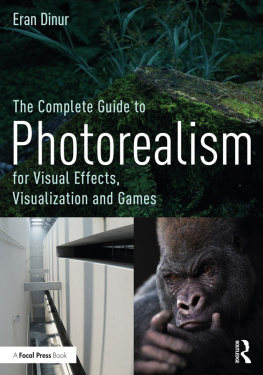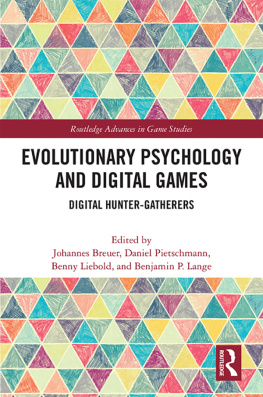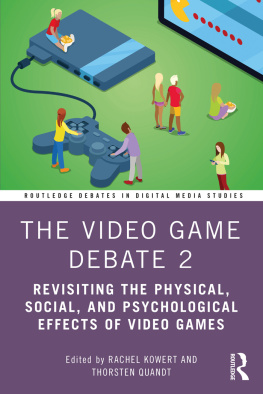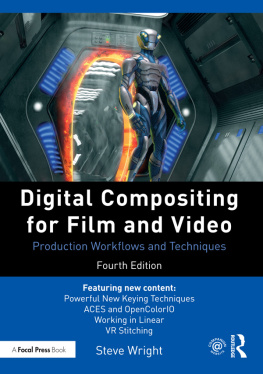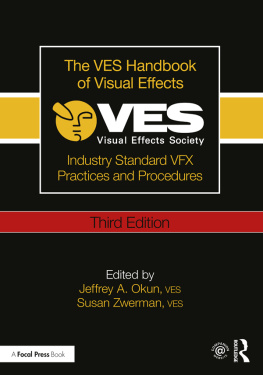The Complete Guide to Photorealism for Visual Effects, Visualization and Games
This book offers a comprehensive and detailed guide to accomplishing and perfecting a photorealistic look in digital content across visual effects, architectural and product visualization, and games.
Emmy award-winning VFX supervisor Eran Dinur offers readers a deeper understanding of the complex interplay of light, surfaces, atmospherics, and optical effects, and then discusses techniques to achieve this complexity in the digital realm, covering both 3D and 2D methodologies. In addition, the book features artwork, case studies, and interviews with leading artists in the fields of VFX, visualization, and games. Exploring color, integration, light and surface behavior, atmospherics, shading, texturing, physically based rendering, procedural modeling, compositing, matte painting, lens/camera effects, and much more, Dinur offers a compelling, elegant guide to achieving photorealism in digital media and creating imagery that is seamless from real footage.
Its broad perspective makes this detailed guide suitable for VFX, visualization and game artists and students, as well as directors, architects, designers, and anyone who strives to achieve convincing, believable visuals in digital media.
Eran Dinur is an Emmy and VES award-winning VFX supervisor, artist, and author of The Filmmakers Guide to Visual Effects (2017). His film and TV work includes: The Trial of the Chicago 7, Hereditary, The Greatest Showman, Uncut Gems, The Wolf of Wall Street, Boardwalk Empire, Star Trek, and Iron Man. He is an adjunct professor at the School of Visual Arts and the author of several popular VFX courses at fxphd.com.
The Complete Guide to Photorealism
For Visual Effects, Visualization and Games
Eran Dinur

First published 2022
by Routledge
605 Third Avenue, New York, NY 10158
and by Routledge
2 Park Square, Milton Park, Abingdon, Oxon, OX14 4RN
Routledge is an imprint of the Taylor & Francis Group, an informa business
2022 Taylor & Francis
The right of Eran Dinur to be identified as author of this work has been asserted by him in accordance with sections 77 and 78 of the Copyright, Designs and Patents Act 1988.
All rights reserved. No part of this book may be reprinted or reproduced or utilised in any form or by any electronic, mechanical, or other means, now known or hereafter invented, including photocopying and recording, or in any information storage or retrieval system, without permission in writing from the publishers.
Unless otherwise noted in the captions, all photographs and artwork Eran Dinur.
All illustrations Ben Zylberman.
Trademark notice: Product or corporate names may be trademarks or registered trademarks, and are used only for identification and explanation without intent to infringe.
Library of Congress Cataloging-in-Publication Data
Names: Dinur, Eran, author.
Title: The complete guide to photorealism for visual effects, visualization and games / Eran Dinur.
Description: New York, NY : Routledge, 2021. | Includes index.
Identifiers: LCCN 2021012600 (print) | LCCN 2021012601 (ebook) | ISBN 9780367199258 (hardback) | ISBN 9780367199265 (paperback) | ISBN 9780429244131 (ebook)
Subjects: LCSH: Rendering (Computer graphics) | Photo-realism. | Digital imagesEditing. | Digital cinematography. | Architectural renderingTechnique. | Video gamesDesign. | CinematographySpecial effects.
Classification: LCC T385 .D585 2021 (print) | LCC T385 (ebook) | DDC 776dc23
LC record available at https://lccn.loc.gov/2021012600
LC ebook record available at https://lccn.loc.gov/2021012601
ISBN: 978-0-367-19925-8 (hbk)
ISBN: 978-0-367-19926-5 (pbk)
ISBN: 978-0-429-24413-1 (ebk)
DOI: 10.4324/9780429244131
Typeset in Avenir
by Apex CoVantage, LLC
Dedicated to my father, Ouri Dinour, 19342020
CONTENTS
Guide
ACKNOWLEDGMENTS
Writing this book was a true journey for me, and I would like to thank all the people who supported me along the way, and shared their expertise, insight, and talent.
Many thanks to Dr. Amodsen Chotia of the University of Paris for his invaluable help in clarifying complex physical concepts of light and light-surface interaction, and to my friend Dr. Ariel Lindner for connecting us.
A big fat thank you to my colleague Ben Zylberman for creating the books superb illustrations, and for being ever so patient toward my never-ending requests.
I would like to thank all the talented artists from around the world who kindly contributed some of their brilliant artwork to this book: Benjamin Bardou, Carlos Colorsponge, Christoph Schindelar, David Edwards, Gregory Smith, Hadi Karimi, Javier Wainstein, Jeff Heral, Jose Iuit, Liam Cramb, Luke Panayiotou, Marvin Funke, Massimo Righi, Maxchill Patiphan, Raphael Rau, Robert Berg, Tamas Medve, and Terje Hannisdal. Thanks also to Brainstorm Digitals artists and founders Richard Friedlander and Glenn Allen for allowing me to use images from our demo reels, and to John Montgomery and Eduardo Abon for allowing me to use footage from my fxphd compositing course.
I owe special gratitude to a unique group of artists who offered not just their artwork, but also words of wisdom that shed light on their own creative process: Aron Kamolz, Daniel Bayona, Dax Pandhi, Julian Sadokha, Pasquale Scionti, and Sarah Scruggs.
Many thanks to Jimmy Calhoun, Jesse Flores, and the anonymous peer reviewers for providing their thoughtful and illuminating feedback. To Nick Constandy and Manuel Riedl for all those fascinating discussions about reality, CG, and photorealism.
Many thanks to the Routledge editorial and production team, and in particular: Simon Jacobs and John Makowsky for helping me take the first steps of the journey, Katherine Kadian for overseeing the entire process, Alyssa Turner for her continuous assistance and advice every step of the way, copy editor Jane Fieldsend, and production editor Helen Evans.
To my amazing family how can I ever thank you enough? Karin, my partner in life, and Ayala, my daughter, for your patience, wisdom, and understanding, and Yotam, my son, for helping me all along the way as an advisor, an editor, a games expert, and a sharp-eyed critic. I love you all so much!
Finally, to my dear father: Aba, I featured your sunset photographs in the book, just like I told you I would! I wish you could be here with us to see how it all came out.
I dedicate this book to your memory.
Introduction
DOI: 10.4324/9780429244131-1
Photorealism is a vital component in digital visual media: in visual effects, seamless integration with live action footage is crucial for telling a believable visual story, and photorealism lies at the core of all successful VFX magic. In architectural and product visualization, photoreal CG renders are now the norm, and often replace photography in advertisements, presentations, and catalogues. Photorealism in video games is constantly evolving along realtime rendering technologies, with new games consistently raising the bar. Recent developments in virtual and augmented reality bring new challenges for synthesized realism and immersive experiences.
Yet despite the technological advancements and the wealth and quality of tools available to digital artists, achieving photorealism in digital media remains a complex, challenging, and often elusive goal. Multiple factors come into play, and these factors stretch across different crafts, from modeling, texturing, and shading, to lighting, matte painting, and compositing. Think about creating photoreal content, and numerous questions come to mind: how do you generate imagery that is indistinguishable from real photographs? How do you successfully emulate light and its interactions with surfaces? How much detail is needed to make digital visual content convincingly real? How to avoid the dreaded CG look? How to achieve realistic daylight and atmospheric depth? How to get the best out of physically based renderers? What are BRDF shaders? How can render passes help in compositing? How to seamlessly blend 2D elements? And so on, and so on

